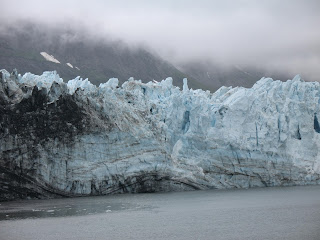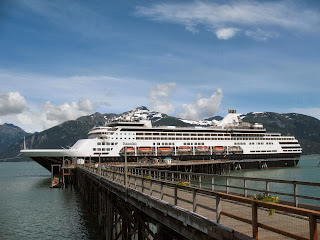On to Anchorage
After our great time at Denali National Park, we again
boarded the McKinley Express. It was a
long trek, but the cars are comfortable with great food service, and of course
scenery. You just leave some mountains
and think that is it, and another range crops up in the distance. It was interesting to see the changes in
types of foliage from Denali as we descended toward near sea level. Denali is on the west northeast side of the
Alaska Range…higher and colder. We
received periodic updates about the scenery and this history of the
people. One comment rang true “People
are part of the Alaskan story!”
 |
|
Great scenery in every
direction most of the way to Anchorage.
|
 |
|
Wasilla, Alaska, north of
Anchorage, is home to Sarah Palin, where she was mayor before becoming
governor.
|
 |
| Anchorage with Cook Inlet in the background. |
July 7 – Cruise Train to Seward
The next train ride from
Anchorage to Seward was on what is call the Cruise Train. It is not the McKinley Explorer owned by
Holland America. These are tourist cars
owned and pulled by Alaskan Railway. H-A
pays for the service. They had nice
large windows, but not the big second level dome like the first two days. Our waiter was an H-A employee. This portion of the trip was non-stop
mountains with a lot of great scenery inaccessible only by train. For a time it follows the Cook Inlet Arm at
sea level on down the Kenai Peninsula.
The Kenai Mountain Range mountains are 3,000 to 4,000 feet high, which
seems large quickly rising from sea level.
If I were to go back, I
would like to fly to Anchorage and rent a car and visit a lot of the sites on
this peninsula.
We were alerted to keep an
eye out for wild life. We did see a
couple moose. Bears are in this
area. In fact 92% of all US bears are in
Alaska.
The Alaskan Railway is the
last “white flag railway” in the US, people who live close to the tracks can
hold up a white flag and the train will stop for them. They are charged for the distance they plan
to go. It is often their only way to
town.
 |
|
Great view along the Cook
Inlet. It was a cloudy day, put the
clouds provided for dramatic photography.
|
 |
| Dress up night!
|
Glacier Bay National Park
After the long journey at
sea, the ship began the trip up Glacier Bay, which is a National Park that many
people don’t know about. It is
accessible only by boat or plane. Members
of the National Park Service boarded our vessel and gave talks along the way. It is fascinating for many reasons including
the fact it is relative a newborn land.
Glacier Bay is a product
of the Little Ice Age which reached it maximum extent about 1750. In the 1600s,
much of the area was glacier free. By
1750 a huge glacier more than 100 miles
long and several thousand feet deep covered the whole area that we were seeing
then quickly retreated nearly 65 miles by 1880.
More has retreated today, although it was pointed out that others are
advancing.
The area was home to the Huna
Tlingit people who had to move relatively quickly as the glacier grew. Now, scientists are studying findings beneath
the water and along the shore that give hints about this tribe prior to the
glacial push. The Tlingit returned
eventually and are enjoying a modern life, while also embracing their homeland.
One of the speakers
referred to this land as the “Geography of Hope.”
The ship made its way to
the north end of the bay where we stopped for over an hour to get closeup views
of Margerie Glacier. This was so
fascinating. For many, getting so close
to these glaciers is the highlight of the trip.
It was though you could
almost touch the ice. You can see in the
photos that some of the ice appears blue.
That is because the ice (which is not really ice, but heavily compacted
snow), does not absorb the color blue, but rather reflects it back; hence, our
eyes see the blue color with the white.
Much of gray or black you see in the photos is the debris that is carved
out as the glacier pushed down from the mountain.
 |
| Calving, or large chunks breaking off Margerie Glacier |
After lengthy glacier
viewing, the ship headed south. It was a
great day. We though it might not be
that great due to the low clouds, but actually the guides said it was a better
day to see the blueness of the ice. This
was definitely awe inspiring, especially for us flatlanders!
Haines, Alaska – July 10
The ship travels at night
back down glacier Bay and around to what is called Lynn Canal and then north to
a small town called Haines. When we opened the drapes we saw sun,
something not seen for any length since we got on the boat. This area gets
between 200 and 300 inches of snow per year!
One of the options was to
take a small boat up to a larger town – Skagway – but we opted to stay here and
take a local site seeing tour. We took a
quick driving tour through what was originally historic Fort Seward, the first
US military base in Alaska. The we
arrived at the American Bald Eagle Foundation’s Raptor Center, an interpretive
wildlife education center. We got to see
a live feeding of Eagles and learned more about the wildlife of the area.
 |
|
All the live creatures at this center have been
injured to the extent they cannot be released into the wild.
|
 |
|
We enjoyed the detailed information we learned about
the eagles. We saw a lot of them on our
trip.
|
 |
| Merry KissMoose |
After the visit to the
interpretive center, we headed to the oldest working cannery in Alaska, owned
and operated by the Haines Packing Company. It was started in 1917. We saw the processing of crab and salmon We learned that sockeye and King are the most
desired salmon. The lighter colored Chum
salmon are not is good.
 |
|
Beautiful scenery on the way to the cannery (right
center).
|
 |
|
Some of the products from Haines Cannery
|
 |
|
Sockeye salmon left; Chum salmon right.
|
After the nice tour, we
reboarded our ship for our afternoon and overnight sailing
July 11 – Juneau – Mendenhall Glacier and Whale
Watching
Juneau is the capitol of
Alaska, although it is far from the mainland of
the state. It must be accessed by
boat or plane by much of the state.
Our shore excursion for
the day included a visit to the Mendenhall Glacier and later a nice whale
watching outing with great lunch.
Mendenhall, a few miles
north of Juneau, is a retreating glacier. Alaska’s best known river of ice is part of the
Juneau Icefield which exceeds 100 feet of annual snowfall. It contains a beautiful visitor center, which
every year gets a little further from from the glacier as it retreats. At one time it was 2.5 miles further down the
valley in the 1700s when the latest glaciation period began to reverse.
It was not a very nice day
(at least then), but we did get good glimpses of the glacier.
From Mendenhall we were
transported to scenic Auke Bay where we boarded a water jet-powered catamaran
designed for wildlife viewing.
 |
The captain had been alerted to an Orca whale pod siting. The trip to that spot was beautiful in itself as the lowering clouds lifted and we had many good panoramas of surrounding mountains.
Soon we arrived where the
small Orca pod (named T-74 group) had been spotted. This is called a transient group that is not
here all the time as opposed to resident pods.
Because of a recognized shape and markings on the dorsal fin of the
pod’s leader, whale watchers know which groups these are. This pod has been seen periodically in this
area since 1977. Transient eat other
mammals. Resident pods do not.
After spending significant
time viewing this pod, we headed back toward Orca Lodge. We were able to see a bit of a humpback whale
(large) which had been named “Sasha.”
Again, the whales can be identified, by markings, this time in shape and
notches in its tail. Sasha travels to
this area every year from Hawaii where she spends the winter (not a bad idea!).
It takes 30 days for the whale to travel each direction.
This spot in the bay was
close to Orca Lodge where we had a nice salmon lunch.
After lunch we took a walk
around some of the touristy stores in Juneau near our boat before boarding for
our trip south.
The next morning we
arrived at Ketchikan. With steady rains
and shore excursions that didn’t interest us that much, we decided to stay on
the boat all day. When cruising that’s
always and option and there are usually things to do to keep you occupied, or
in this case, sit in a comfy chair and read…or go to the spa for a massage.
Where our ship was docked,
we had a nice view of the town, through the rain.
After the overnight
cruise, we wound up going through the “inside passage” the next day. It was a beautiful day in the 70s and was so
pleasant to sit out on the back deck and watch the beautiful scenery go by…
The last night aboard the
Statendam was spent repacking for disembarking in Vancouver the next
morning. Our long trip was coming to an
end. No more getting waited on hand and
foot!!!
Once we arrived in
Vancouver, we could watch from our balcony as the ship was emptied and quickly
loaded with tons of food for the next cruise going back north
We stayed at a hotel in
central Vancouver prior to our very early flight home the next day, July 15th. It was a great tour…lots of information to
absorb and scenery to see. We certainly
recommend spending plenty of time on a land tour as well as the cruise. It’s a fabulous land and probably much
different than wherever you have come from.
We can also recommend
Holland-America. We were so impressed
with how flawlessly they handled every detail, especially on the land portion
of the tour. People were going in different
directions, part of different tours, and moving to different destinations each
day. Their baggage tag system was
helpful and the bags were always in our room the next day!












































The tour is the best period for enjoyment. And this enjoyment becomes double if you are enjoying your tour at some special destination. This will give you the chance to have the joy at https://www.imanali.in/manali-tour-package-trivandrum of the beautiful sights of that destination. This will make your tour more special and memorable.
ReplyDelete